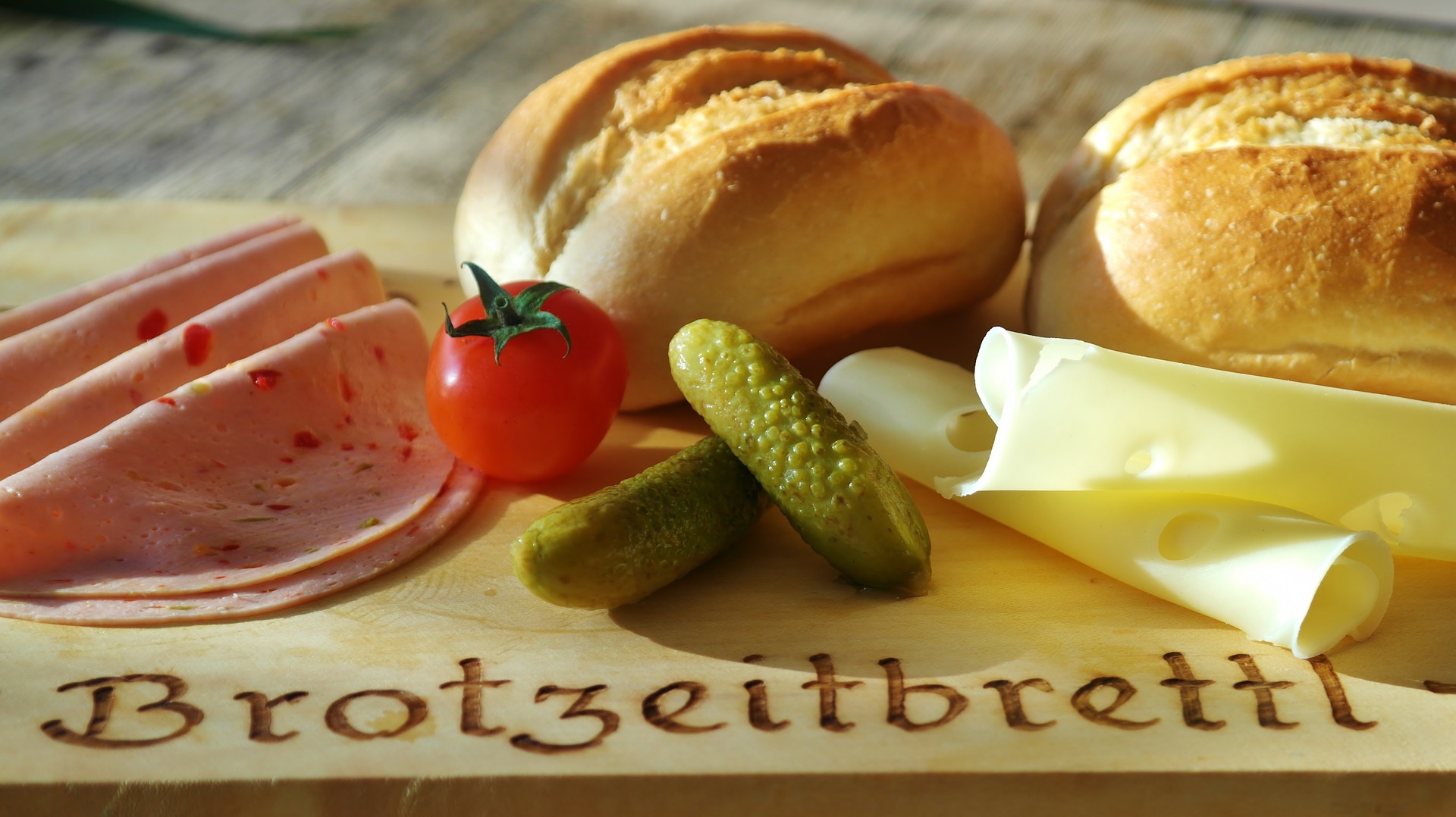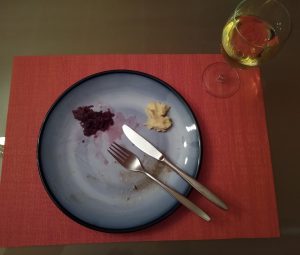9.8: 9.6
- Page ID
- 123636
Einheit 9.6 (online)
 |
Mӧchten Sie ein Brotzeitbrettl? Hier ist eine Internetseite, wo Sie es bestellen kӧnnen. |
![]() Übung 1
Übung 1
Adjective Endings
In Einheit 3, you already learned the adjective endings for the der-words and the ein-words in the nominative case (Einheit 3.6) and in the accusative case (Einheit 3.10), and in Einheit 5, you learned the adjective endings in the dative case (Einheit 5.10). Here are some tables for review:
der-words
| masculine | feminine | neuter | plural | |
| nominative | der starke Kaffee | die italienische Salami | das kalte Bier | die frischen Brӧtchen |
| accusative | den starken Kaffee | die italienische Salami | das kalte Bier | die frischen Brӧtchen |
| dative | dem starken Kaffee | der italienischen Salami | dem kalten Bier | den frischen Brӧtchen |
Beispiele:
Nominative: Das kalte Bier schmeckt gut!
Accuative: Hast du diesen starken Kaffee gemacht?
Dative: Mit der italienischen Salami schmeckt das Brot besonders gut!
ein-words
| masculine | feminine | neuter | plural | |
| nominative | ein starker Kaffee | eine italienische Salami | ein kaltes Bier | keine frischen Brӧtchen |
| accusative | einen starken Kaffee | eine italienische Salami | ein kaltes Bier | keine frischen Brӧtchen |
| dative | einem starken Kaffee | einer italienischen Salami | einem kalten Bier | keinen frischen Brӧtchen |
Beispiele:
Nominative: Ein starker Kaffee ist wichtig am Morgen.
Accusative: Magst du keine frischen Brӧtchen?
Dative: Mit einem kalten Bier kann man gut relaxen.
There are also circumstances when there is no article in front of the adjective. We call these “unpreceded” and the adjective takes the ending of the der-words.
unpreceded (=no article in front of the adjective)
| masculine | feminine | neuter | plural | |
| nominative | starker Kaffee | italienische Salami | kaltes Bier | frische Brӧtchen |
| accusative | starken Kaffee | italienische Salami | kaltes Bier | frische Brӧtchen |
| dative | starkem Kaffee | italienischer Salami | kaltem Bier | frischen Brӧtchen |
Beispiele:
Nominative: Italienische Salami ist am besten!
Accusative: Ich trinke gern starken Kaffee!
Dative: Von kaltem Bier bekomme ich Bauchschmerzen 🙁
*ACHTUNG* Remember, many prepositions take a specific case in German. Here is a list of the most common prepositions and their case.
![]() Übung 2: Trattoria Da Fausto.
Übung 2: Trattoria Da Fausto.
![]() Übung 3: Im Restaurant. Nicole, Mehmed und Mia gehen zu ihrem Lieblingsrestaurant in Stuttgart.
Übung 3: Im Restaurant. Nicole, Mehmed und Mia gehen zu ihrem Lieblingsrestaurant in Stuttgart.
![]() Am Esstisch
Am Esstisch
Wie lege ich mein Besteck richtig hin?
Using your cutlery appropriately can send clear messages.
| At the beginning of a meal, your knife and fork are placed either on each side of the plate or together at the right side of the plate. | 
(bratwurst mit Rotkohl und ) |
| Imagine your plate is a clock. When you pause during your meal, you place your fork at 8 o’clock and your knife at 4 o’clock. This signals that you are not done eating yet and that you’re just taking a little break.
|
 |
| When you’re done eating, you place both fork and knife at 4 o’clock in a parallel manner.
|
 or or  |
Here are a few more tips on good table etiquette. Only watch the video to 1:48.
![]() Was wissen Sie jetzt? Klicken Sie hier für Quiz 9.6.
Was wissen Sie jetzt? Klicken Sie hier für Quiz 9.6.
Media Attributions
- snack-1415680_1920 © RitaE is licensed under a Public Domain license
- star © IO-Images is licensed under a Public Domain license
- presentation icon © quinntheislander adapted by Solomon Hajramezan is licensed under a Public Domain license
- Rehbratwurst mit Rotkohl und Kartoffelbrei © ckost is licensed under a Public Domain license
- Pause beim Essen © ckost is licensed under a Public Domain license
- fertig mit dem Essen 1 © ckost is licensed under a Public Domain license
- fertig mit dem Essen 2 © ckost is licensed under a Public Domain license
- link © IO-Images is licensed under a Public Domain license
- check mark © janjf93 adapted by Solomon Hajramezan is licensed under a Public Domain license

